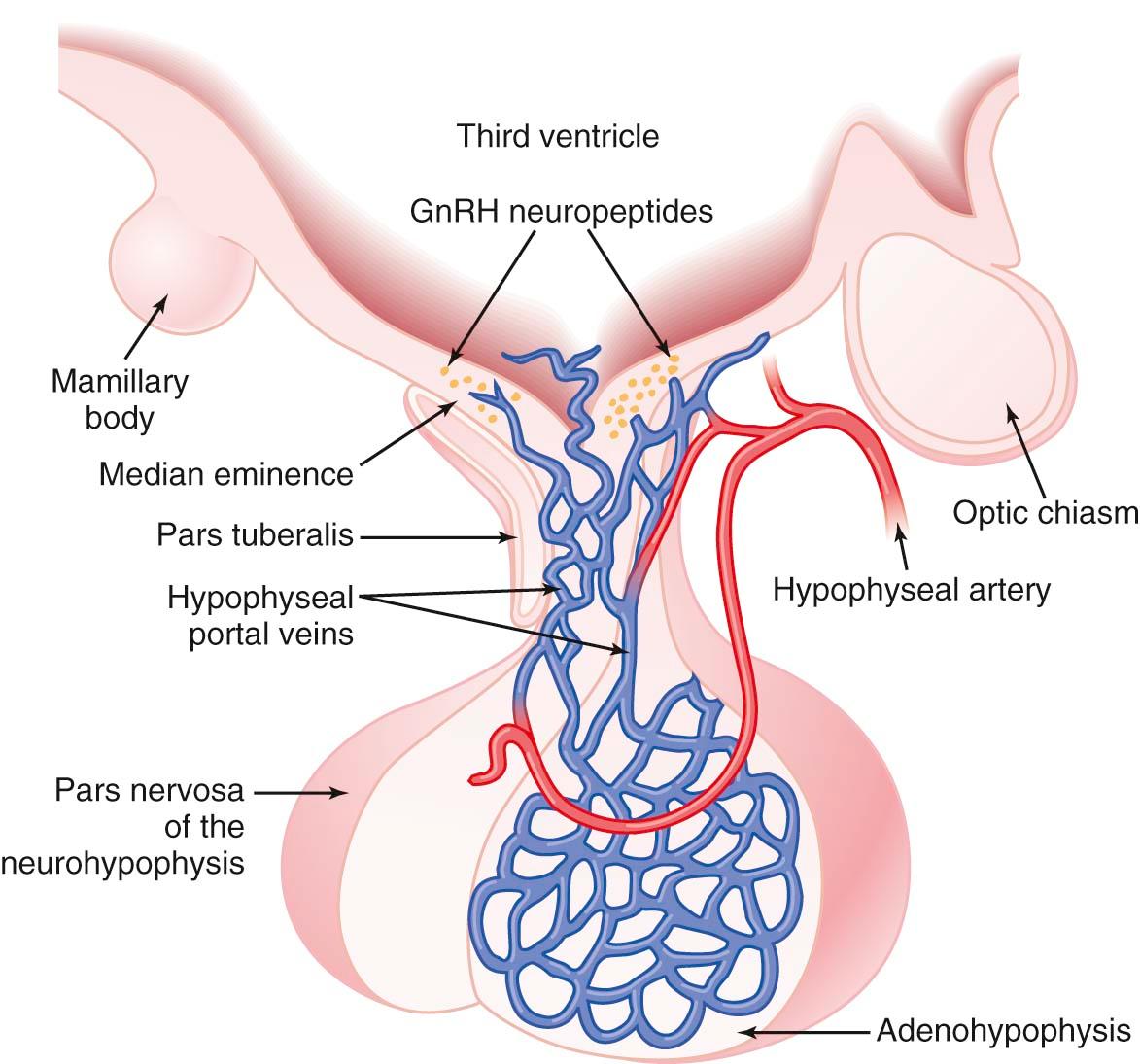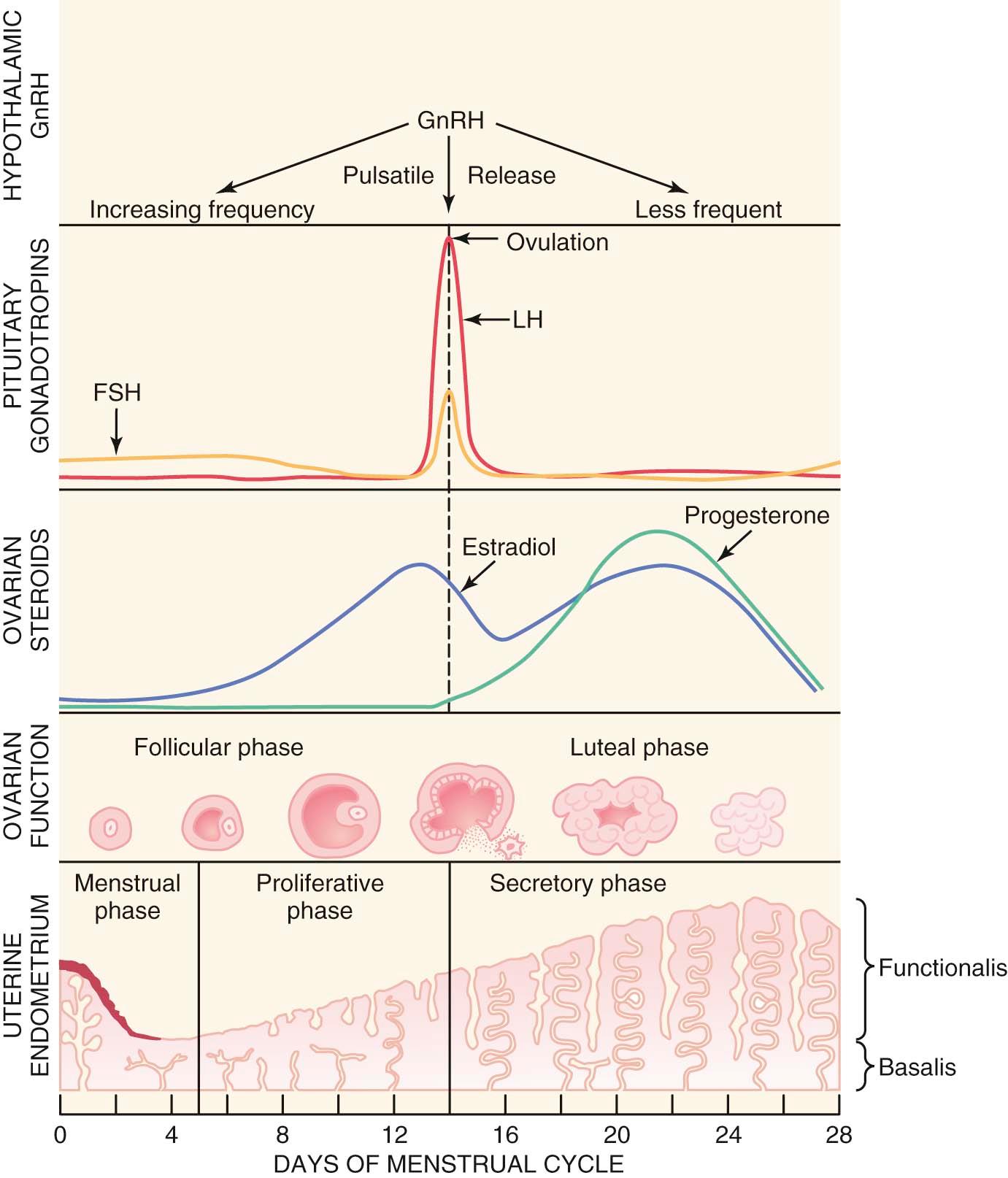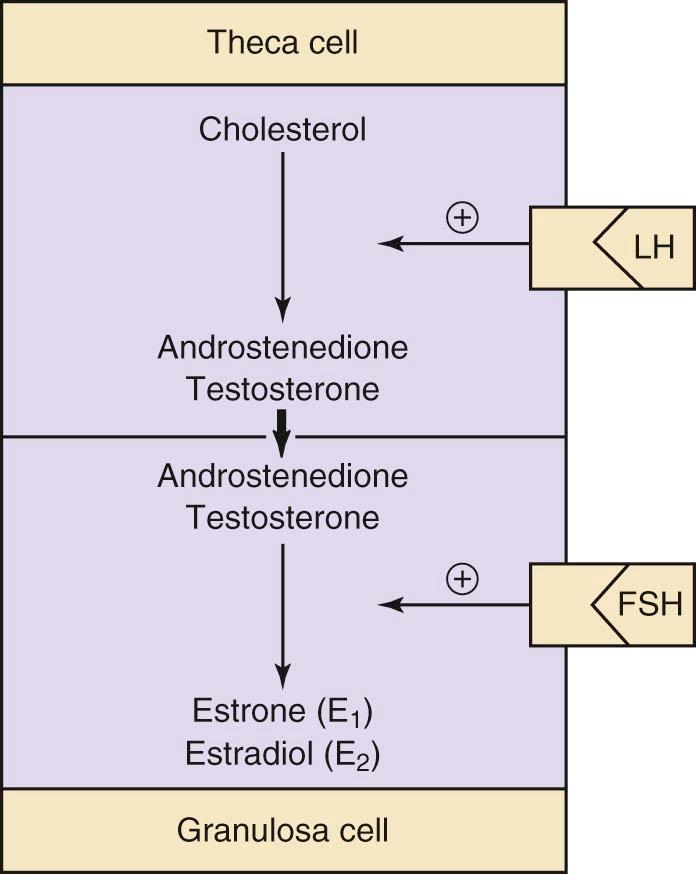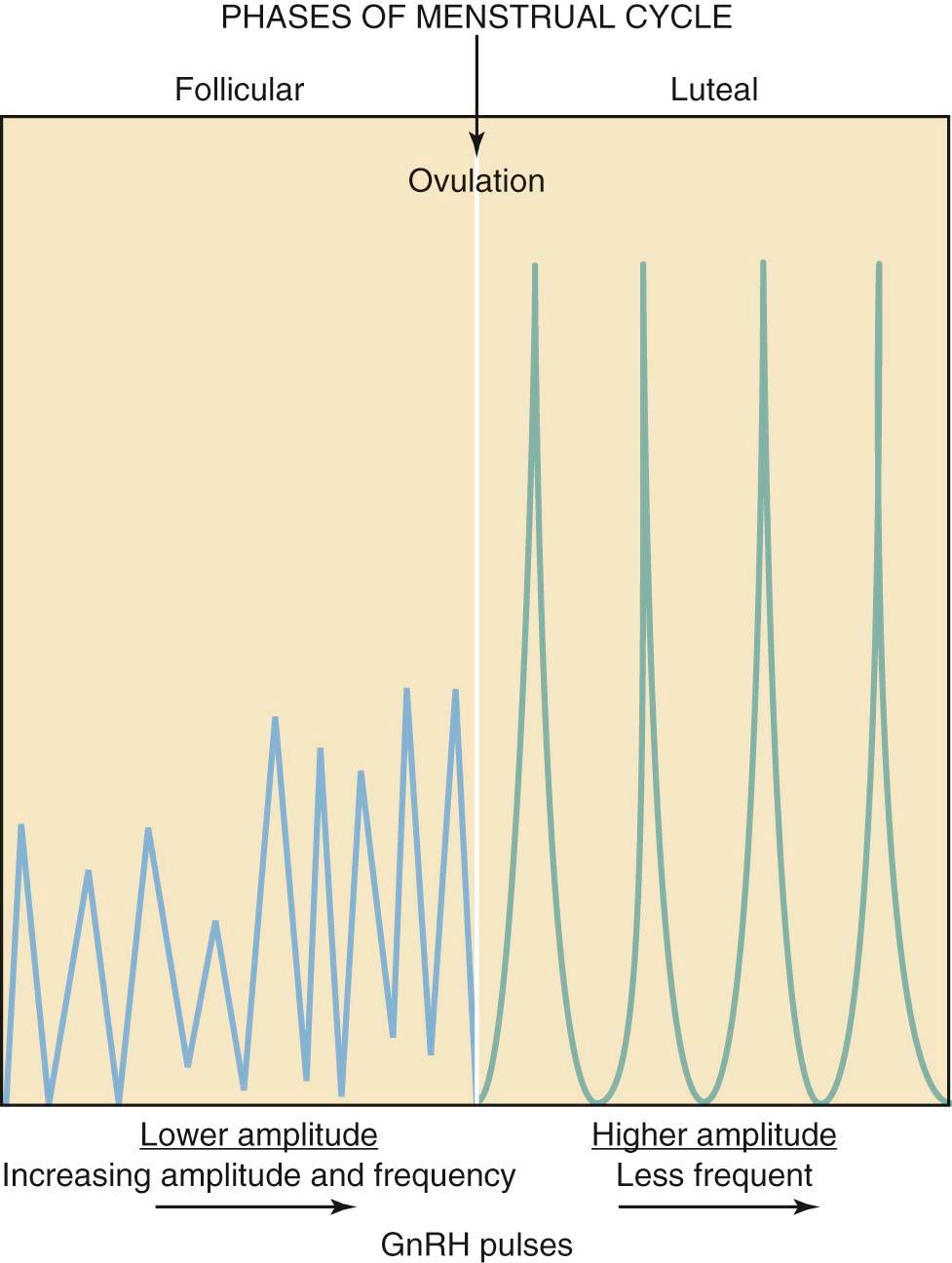Physical Address
304 North Cardinal St.
Dorchester Center, MA 02124
The female reproductive cycle (menstrual cycle) may be viewed as four separate physiologic cycles (hypothalamic, pituitary, ovarian, and endometrial) but is actually a highly complex and integrated event. This 28 (±7) day cycle allows for the maturation and release of an oocyte (usually only one) that if fertilized may implant in a receptive endometrium. If fertilization and implantation do not occur, the end result is menstruation.
Communication between the hypothalamus, which releases gonadotropin-releasing hormone (GnRH) in pulses, and the pituitary gland is essential to permit the pituitary to respond to changes in ovarian hormones (estradiol and progesterone) and other factors. This essential communication results in both negative and positive feedback for the release of the pituitary gonadotropins, luteinizing hormone (LH) and follicle-stimulating hormone (FSH). These gonadotropins, also released in pulses, stimulate follicular growth in the ovary (FSH) such that one dominant follicle releases an oocyte in response to a midcycle surge in LH. Other growth factors and peptides such as inhibin-A, inhibin-B, and activin act systemically and locally to control follicular growth.
After oocyte release, the dominant (graafian) follicle becomes the corpus luteum and secretes both estradiol (E2) and progesterone (P4). The endometrium responds to E2 with growth or proliferation before ovulation and to P4 and E2 after ovulation with maturation that allows for implantation if fertilization occurs. The corpus luteum continues to maintain the uterine lining, stimulated by human chorionic gonadotropin (hCG) from the placental tissue if a pregnancy occurs.
Fertilization and implantation begin with normal sperm function and penetration of the oocyte in the fallopian tube. Fertilization restores the diploid number of chromosomes and determines the sex of the zygote. The fertilized ovum reaches the endometrium about 3 days after ovulation and after another several days the blastocyst implants.
As the blastocyst burrows into the endometrium, the trophoblastic strands branch to form the primitive villi. The villi are first distinguished about the 12th day after fertilization and are the essential structures of the placenta. The placenta is the life-support system for the developing fetus for the rest of pregnancy.
Each female reproductive cycle (menstrual cycle) represents a complex interaction between the hypothalamus, pituitary gland, ovaries, and endometrium. Cyclic changes in the gonadotropins, luteinizing hormone (LH), and follicle-stimulating hormone (FSH) and sex steroid hormones, mainly estradiol (E2) and progesterone (P4), induce functional as well as morphologic changes in the ovary, resulting in follicular maturation, ovulation, and corpus luteum formation. Similar changes at the level of the endometrium allow for successful implantation of the fertilized ovum or a physiologic shedding of the menstrual endometrium when an early pregnancy does not occur. By convention, the normal cycle begins on the first day of menstrual bleeding and ends just before the first day of the next menses. The average length of each cycle is 28 (±7) days.
The reproductive cycle can be viewed from the perspective of each of four physiologic components ( Table 4-1 ). The cyclic changes within the hypothalamic-pituitary axis, ovary, and endometrium are sequentially approached in this chapter, as if they were four separate cycles, but these endocrine events occur in concert in a uniquely integrated fashion. The chapter also includes a discussion of spermatogenesis, fertilization, implantation, and placentation.
| Component | Activity | Phases | Comment(s) |
|---|---|---|---|
| Hypothalamic (arcuate nucleus) | Produces pulses of GnRH from the arcuate nucleus. GnRH has a very short half-life of 2-4 min. Action requires frequent pulses. GnRH is sometimes referred to as LH-RH because it generally causes a greater release of LH. | Frequency of pulses is variable among individuals. Pulses are more frequent and lower amplitude in follicular phase and less frequent but higher amplitude in luteal phase (see Figure 4-4 ). The hypothalamic component changes the least on a daily basis. | Permits the other components of the cycle to act and react. If pathology or medications (e.g., hormonal contraceptives or GnRH analogues) disrupt pulses, the entire cycle stops. When GnRH is given in a continuous infusion (no pulses) downregulation inhibits LH and FSH release. |
| Pituitary (anterior) | Produces pulses of LH and FSH from the anterior portion of gland. LH half-life is 30 min, FSH half-life is several hours. |
Negative feedback initially with strong positive feedback resulting in LH surge and ovulation. | Surge of LH at midcycle triggers ovulation, maturing the oocyte and releasing it from the follicle. |
| Ovarian | Theca cells produce androgens in response to LH. Granulosa cells aromatize androgens to estrogens in response to FSH (see Figure 4-3 ). Ovarian inhibins (A and B) inhibit and activin stimulates gonadotropins. | Follicular, ovulatory, and luteal phases. Average overall cycle length is 28 (±7) days. Luteal phase is generally constant at 12 to 14 days. Follicular phase may vary. | LH triggers ovulation at midcycle. LH then stimulates the corpus luteum to produce P4 and some E2. With pregnancy, placental hCG rescues the corpus luteum by mimicking LH. |
| Endometrial | Estradiol (E2) from the ovary stimulates growth (proliferation) and progesterone (P4) from the corpus luteum converts endometrium to secretory and withdrawal of E2 and P4 leads to menstruation (see Figures 4-7 and 4-8 ). | Menstrual, proliferative, and secretory phases. The endometrial component changes the most on a daily basis. Histology may be used to “date” the endometrium and determine day of cycle. | Menstruation is the only visible component. Because it is visible, it is where the cycle is said to start but menstruation actually represents the end of the previous cycle. |
The pituitary gland lies below the hypothalamus at the base of the brain within a bony cavity (sella turcica) and is separated from the cranial cavity by a condensation of dura mater overlying the sella turcica (diaphragma sellae). The pituitary gland is divided into two major portions, the neurohypophysis and the adenohypophysis ( Figure 4-1 ). The neurohypophysis, which consists of the posterior lobe (pars nervosa), the neural stalk (infundibulum), and the median eminence, is derived from neural tissue and is in direct continuity with the hypothalamus and central nervous system. The adenohypophysis, which consists of the pars distalis (anterior lobe), pars intermedia (intermediate lobe), and pars tuberalis, which surrounds the neural stalk, is derived from ectoderm.

The arterial blood supply to the median eminence and the neural stalk (pituitary portal system) represents a major avenue of transport for hypothalamic secretions to the anterior pituitary.
The neurohypophysis serves primarily to transport oxytocin and vasopressin (antidiuretic hormone) along neuronal projections from the supraoptic and paraventricular nuclei of the hypothalamus to their release into the circulation.
The anterior pituitary contains different cell types that produce six protein hormones: follicle-stimulating hormone (FSH), luteinizing hormone (LH), thyroid-stimulating hormone (TSH), prolactin, growth hormone (GH), and adrenocorticotropic hormone (ACTH).
The gonadotropins, FSH and LH, are synthesized and stored in cells called gonadotrophs, whereas TSH is produced by thyrotrophs. FSH, LH, and TSH are glycoproteins, consisting of α and β subunits. The α subunits of FSH, LH, and TSH are identical. The same α subunit is also present in human chorionic gonadotropin (hCG). The β subunits are individual for each hormone. The half-life for circulating LH is about 30 minutes, whereas that of FSH is several hours. The difference in half-lives may account, at least in part, for the differential secretion patterns of these two gonadotropins.
Prolactin is secreted by lactotrophs. Unlike the case with other peptide hormones produced by the adenohypophysis, pituitary release of prolactin is under tonic inhibition by the hypothalamus. The half-life for circulating prolactin is about 20 to 30 minutes. In addition to its lactogenic effect, prolactin may directly or indirectly influence hypothalamic, pituitary, and ovarian functions in relation to the ovulatory cycle, particularly in the pathologic state of chronic hyperprolactinemia (see Chapter 33 ).
A normal ovarian cycle can be divided into a follicular and a luteal phase ( Figure 4-2 ). The follicular phase begins with the onset of menses and culminates in the preovulatory surge of LH. The luteal phase begins with the onset of the preovulatory LH surge and ends with the first day of menses.

Decreasing levels of estradiol and progesterone from the regressing corpus luteum of the preceding cycle initiate a rise of FSH by a negative feedback mechanism, which stimulates follicular growth and estradiol secretion. A major characteristic of follicular growth and estradiol secretion is explained by the two-gonadotropin (LH and FSH) two-cell (theca and granulosa cell) theory of ovarian follicular development. According to this theory, there are separate cellular functions in the ovarian follicle wherein LH stimulates theca cells to produce androgens (androstenedione and testosterone) and FSH then stimulates the granulosa cells to convert these androgens into estrogens (androstenedione to estrone and testosterone to estradiol) as depicted in Figure 4-3 . Initially, at lower levels of estradiol, there is a negative feedback effect on the release of LH from the pool of gonadotropins in the pituitary gonadotrophs. When estradiol levels rise later in the follicular phase (>200 picograms for >50 hours), there is a positive feedback on the release of gonadotropins, resulting in the LH surge and ovulation. The latter occurs 36 to 44 hours after the onset of this midcycle LH surge. With pharmacologic doses of progestins contained in contraceptive pills, there is a profound negative feedback effect on gonadotropin-releasing hormone (GnRH) so that none of the gonadotropin pool is released. Hence, ovulation is blocked (see Chapter 27 ).

During the luteal phase, both LH and FSH are significantly suppressed through the negative feedback effect of elevated circulating estradiol and progesterone. This inhibition persists until progesterone and estradiol levels decline near the end of the luteal phase as a result of corpus luteal regression, should pregnancy fail to occur. The net effect is a slight rise in serum FSH, which initiates new follicular growth for the next cycle. The duration of the corpus luteum's functional regression is such that menstruation generally occurs 14 days after the LH surge in the absence of pregnancy. When pregnancy occurs, the corpus luteum is “rescued” by hCG which acts like LH and progesterone production continues.
Five different small peptides or biogenic amines that affect the reproductive cycle have been isolated from the hypothalamus. All exert specific effects on the hormonal secretion of the anterior pituitary gland. They are GnRH, thyrotropin-releasing hormone (TRH), somatotropin release-inhibiting factor (SRIF) or somatostatin, corticotropin-releasing factor (CRF), and prolactin release-inhibiting factor (PIF). Only GnRH and PIF are discussed in this chapter.
GnRH is a decapeptide that is synthesized primarily in the arcuate nucleus. It has a very short half-life of 2 to 4 minutes. It is responsible for the synthesis and release of both LH and FSH. Because it usually causes the release of more LH than FSH, it is less commonly called LH-releasing hormone (LH-RH) or LH-releasing factor (LRF). Both FSH and LH appear to be present in two different forms within the pituitary gonadotrophs. One is a releasable form and the other a storage form. GnRH reaches the anterior pituitary via the hypophyseal portal vessels and stimulates the synthesis of both FSH and LH, which are stored within gonadotrophs. Subsequently, GnRH activates and transforms these molecules into releasable forms. GnRH can also induce immediate release of both LH and FSH into the circulation. Receptors for GnRH have been found in other tissues including the ovary, suggesting that GnRH may have a direct effect on ovarian function as well.
GnRH is secreted in a pulsatile fashion throughout the menstrual cycle as depicted in Figure 4-4 . The frequency of GnRH release, as assessed indirectly by measurement of LH pulses, varies considerably among individuals. GnRH pulses in the follicular phase are more frequent and of lower amplitude, whereas in the luteal phase the pulses occur less frequently but are of higher amplitude.

Intravenous and subcutaneous administration of exogenous pulsatile GnRH has been used to induce ovulation in selected women who are not ovulating as a result of hypothalamic dysfunction. A continuous (nonpulsatile) infusion of GnRH results in a reversible inhibition of gonadotropin secretion through a process of “downregulation” or desensitization of pituitary gonadotrophs. This represents the basic mechanism of action for the GnRH analogues (nonapeptides, containing only nine amino acids) that have been successfully used in the therapy of such ovarian hormone-dependent disorders as endometriosis, leiomyomas (fibroids), hirsutism, and precocious puberty. There are both agonistic and antagonistic analogues of GnRH.
Several mechanisms control the secretion of GnRH. Estradiol appears to enhance hypothalamic release of GnRH and may help induce the midcycle LH surge by increasing GnRH release or by enhancing pituitary responsiveness to the decapeptide. Gonadotropins have an inhibitory effect on GnRH release. Catecholamines may play a major regulatory role as well. Dopamine is synthesized in the arcuate and periventricular nuclei and may have a direct inhibitory effect on GnRH secretion via the tuberoinfundibular tract that projects onto the median eminence. Serotonin also appears to inhibit GnRH pulsatile release, whereas norepinephrine stimulates it. Endogenous opioids suppress release of GnRH from the hypothalamus in a manner that may be partially regulated by ovarian steroids.
The hypothalamus produces PIF, which exerts chronic inhibition of prolactin release from the lactotrophs. A number of pharmacologic agents (e.g., chlorpromazine) that affect dopaminergic mechanisms also influence prolactin release. Dopamine itself is secreted by hypothalamic neurons into the hypophyseal portal vessels and inhibits prolactin release directly within the adenohypophysis. Based on these observations, it has been proposed that hypothalamic dopamine may be the major PIF. In addition to the regulation of prolactin release by PIF, the hypothalamus may also produce prolactin-releasing factors (PRF) that can elicit large and rapid increases in prolactin release under certain conditions, such as breast stimulation during nursing. Neither PIF nor PRF has been clearly characterized biochemically as of 2014. TRH serves to stimulate prolactin release as well. This phenomenon may explain the association between primary hypothyroidism (with secondary TRH elevation) and hyperprolactinemia. The precursor protein for GnRH, called GnRH-associated peptide (GAP), has been identified to be both a potent inhibitor of prolactin secretion and an enhancer of gonadotropin release. These findings suggest that this GnRH-associated peptide may also be a physiologic PIF and could explain the inverse relationship between gonadotropin and prolactin secretions seen in many reproductive states.
Become a Clinical Tree membership for Full access and enjoy Unlimited articles
If you are a member. Log in here